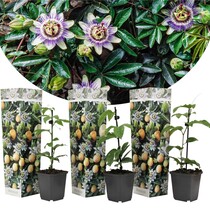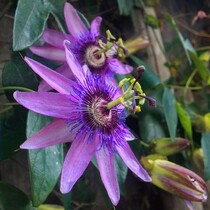Passiflora - Passion Flower - Climbing Plant In Different Species - Hardy
Passiflora Edulis 'Frederick' is the best-known passion flower, this climber produces delicious fruits, the seeds of which are edible. - Fast delivery
Read morePassiflora Lavender Lady Blue is a beautiful climbing plant with pretty purple flowers, there are even edible passion fruit on this plant. - Fast delivery
Read morePassiflora Victoria Red is a beautiful climbing plant with unique red-coloured flowers. Plant this passion flower in full sun. - Fast delivery
Read morePassiflora caerulea ´Avalanche´ is a hardy climber that blooms in the months from May to September with white large flowers.
Read moreWhat are Passiflora?
Passion flowers are well-known perennial climbing plants native to the South American countries of Argentina, Brazil and Paraguay. Today, passionflowers are grown around the tropics and equator worldwide. Also in Europe, passion flowers are offered as seeds or in garden centres as houseplants. Here in Europe, Passiflora edulis (passion flower) and Passiflora caerulea (blue passion flower) are especially popular. They are plants with unique flowers that add a tropical and exotic atmosphere to any garden or living room.
Differences between passion fruit and blue passion flower?
Almost all plants in the passionflower family have a similar appearance. Yet there are demonstrable differences between them. There are also differences between the passion fruit and blue passion flower.
Properties of the Passion Flower
Suitable as houseplant or climbing plant
- Perennial
- Grows 4-5 metres tall on average, sometimes growing up to 10 metres tall
- White sepals
- Inflorescence with elongated petals
- Crown with several rows of white anthers transitioning to a deep purple colour
- Resistant to soil diseases and soil nematodes
- Purple fruits with a fresh sweet-sour taste
- Can self-pollinate, but could do with a helping hand
- Can be propagated
- Where and when to sow Passiflora?
Passiflora are native to countries around the equator. There, they can be found in places where there is a lot of sunlight. Therefore look for a suitable sunny spot. They also like humus-rich soils. If necessary, you can supplement or enrich the soil with potting soil or fertiliser. They are climbing plants and benefit from a place where they can climb. For example, a spot along a fence or wall is the perfect place for these beautiful plants. In that case, sow the seeds about 30 centimetres from the wall. You can also use a planting guide in case you don't want to sow them along a wall or fence.
Plants from the Passiflora family are almost all perennials and can basically be sown all year round. Preferably after the winter months to give the seeds the best possible start.
How do you sow passiflora?
The first step is to prepare the soil properly. You do this by digging it up properly. Are you planning to sow in a large flower box? Then make sure the soil is not compact but airy by turning it over with hand tools such as a hand rake or hand cultivator. You can also add Mediterranean or regular fertiliser if necessary. This will ensure that you can give the passiflora the very best start. Of course, you can also add this after the first seedlings emerge.
You have now prepared the soil properly for the seeds. Now you can start planting the loose seeds. As they are quite large plants, it is advisable to sow about 30 centimetres from a wall or fence. Also, 4 to 5 plants per metre are more than enough. So keep about 20 to 25 centimetres per plant. You can dig a hole 2 to 3 cm deep every 20 to 25 centimetres and put 1 to 2 seeds in it. If two seedlings grow in the same spot, you can always move them or continue growing them indoors. Keep the soil slightly moist for the first two weeks. Make sure the soil is not too wet, as this may cause the seeds to rot or the fertiliser to wash out.
Taking care of passionflower
Both passionflower and passion fruit are very sensitive to European winters. It is therefore important to prepare well for the cold winter months in case you plan to grow passiflora in your garden. Fortunately, both species are moderately hardy and will survive moderate winters just fine. Nevertheless, they could use a hand in harsh winters. You can choose to bring the plants inside during winter and give them a nice spot by the window, or you can cover them outside to protect them from the freezing cold.
Are passiflora edible flowers?
Both Passiflora edulis and Passiflora caerulea produce fruits that are edible. Yet there are differences between the two. The Passiflora edulis is the well-known passion fruit with the purple fruits that you will also find in the supermarket. These have deliciously sweet flavour and are suitable all kinds of sweet treats. The Passiflora caerulea also makes fruits, but it makes yellow-coloured fruits with quite little flavour. These too are edible and a favourite with people who don't necessarily like ant-sweet fruit. You can also use the flowers of the blue passion flower to make tasty tea.
What can you do with passion fruit and passion flowers?
Besides these plants being hugely fun exotic garden plants, you can do a lot more with them. Namely, you can also use the plant as a houseplant. As long as the plant catches enough sun, you will be able to enjoy its flowers and fruits for years. And you can also make tasty things with it. Fruits of these plants are ideal for jams, syrups, or as an ingredient in fruity pastries. How delicious is it to make something delicious with fruit from your own garden or living room? The answer, of course, is a resounding: "incredibly delicious!".
What can you do with passion fruit?
Passion fruits, of course, we all know. You might sometimes see the purple fruits in the fruit and vegetable section of the supermarket or at fruit and vegetable specialists. These fruits of the Passiflora edulis are packed with vitamins A, B, C, E and K. So it is a real superfruit. You can do an incredible amount with it. From loose to processed in desserts and salads. The options are almost endless. This fruit is deliciously sweet and sour in taste, making it the most delicious addition to fresh fruit drinks, smoothies or homemade syrup.
For syrup, put the flesh in a blender and then strain it so that only the liquid remains. Then reduce this on a low heat. Et voilà, you now have a deliciously sweet syrup that you can use as a sweet dressing for salads or dilute again with ice-cold water for a delicious summer drink. And throwing away the strained pulp is a waste, when you put this in an ice cream mould and put it in the freezer you have a delicious healthy fruit ice cream. Also try this with multiple fruits for all kinds of different flavours.
What can you do with passion flowers?
Like the Passiflora edulis, the Passiflora caerulea also produces fruits. These only have a much less intense flavour. Sometimes even a little bitter instead of sweet. Still, you can make a lot of delicious things with them. The purple passion fruits often have a very strong flavour. This makes them ideal for making syrup for drinks. The yellow-orange passionflower fruits are ideal for a homemade jam or marmalade thanks to their less intense flavour. As the passionflower fruit tastes less sweet, it will also not give an overpoweringly sweet taste in a jam or marmalade.
Besides the fruit, you can also use the flowers for a delicious calming tea. In fact, it is a flower that is becoming increasingly popular in herbal medicine, and more and more medical studies are also starting on its effects. What is already known is that its calming effect can be enhanced when combined with valerian. Dried blossom of the plant is therefore ideal for making a delicious sleeping tea blend with valerian and other calming tea ingredients





